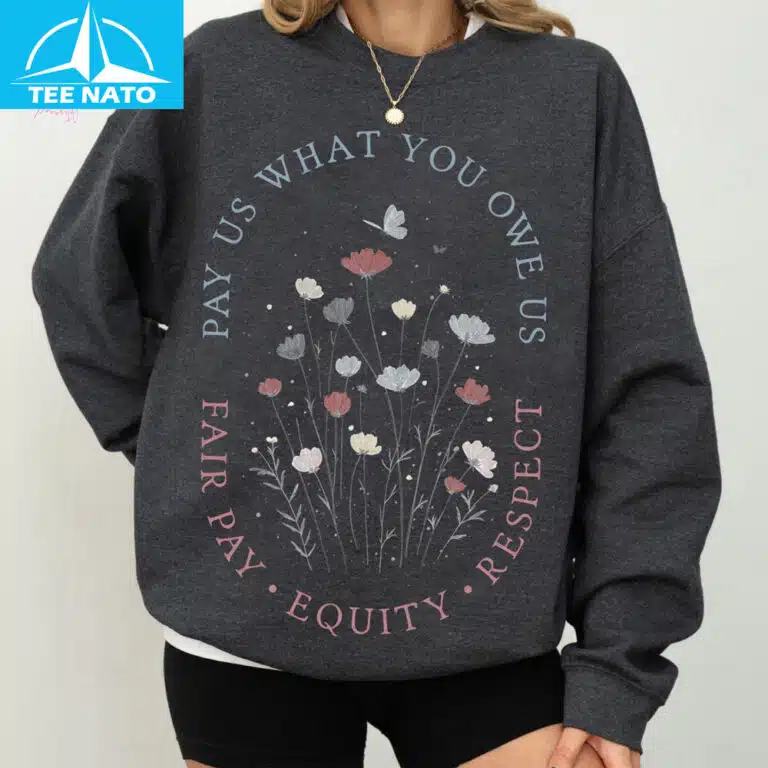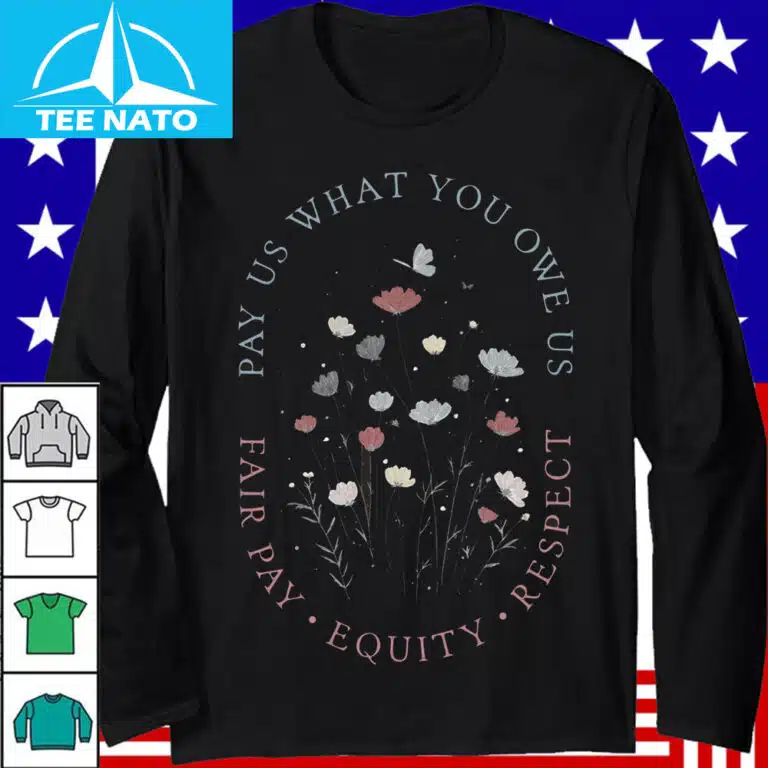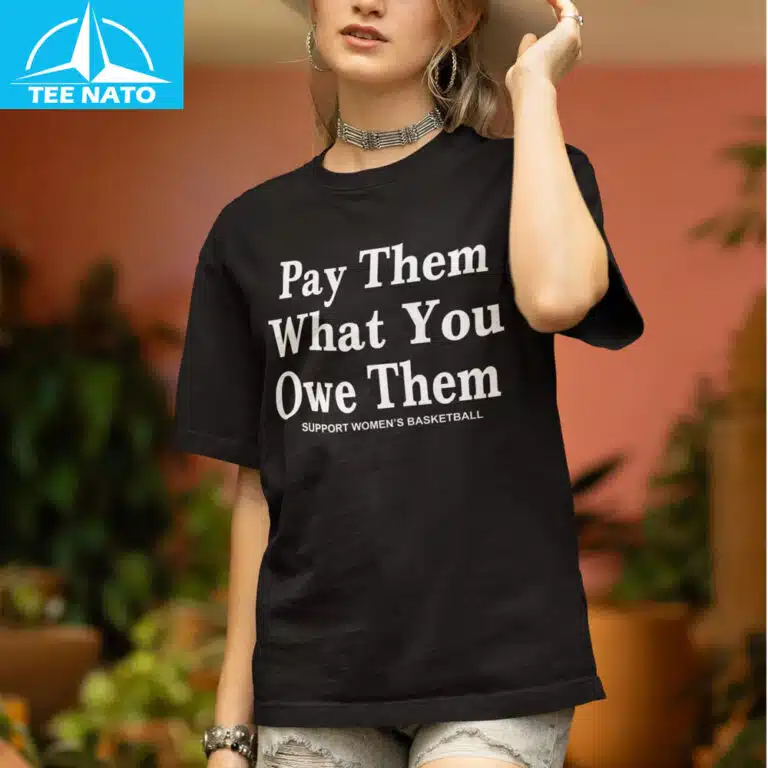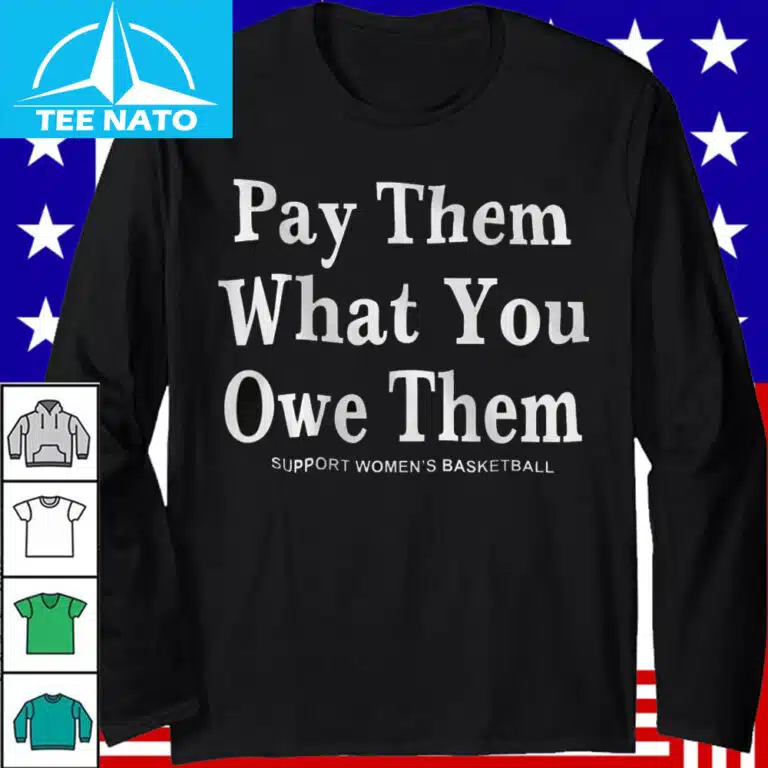Basketball Equity: The “Pay Them What You Owe Them” Women’s Sports Apparel
The “Pay Us What You Owe Us United Hands Apparel” is more than mere clothing—it’s a powerful symbol of solidarity, justice, and a collective demand for fairness. Whether worn at protests, shared widely on social media, or used as an effective conversation starter, this apparel significantly amplifies voices persistently calling for accountability.
Below, we delve into its profound significance, explore practical ways to use it effectively, and highlight why it stands out so prominently in movements dedicated to economic justice.
The “Pay Us What You Owe Us United Hands Apparel” carries deep meaning, robustly representing unity and steadfast resistance against systemic inequities. It stands as a powerful wearable statement that seamlessly bridges the worlds of fashion and impactful activism.
The design—often featuring prominently clasped hands or bold, assertive typography—immediately communicates a message of solidarity. Unlike generic protest slogans, this apparel’s message is exceptionally direct: it unequivocally demands restitution and inherent fairness. Movements centered on wage equality and reparations have indeed adopted similar symbols, but the “Pay Us What You Owe Us United Hands Apparel” distinguishes itself with its remarkable clarity. It effectively transforms the wearer into a vocal advocate, actively sparking crucial discussions on topics such as unpaid labor, corporate accountability, and pervasive systemic exploitation.
From the iconic suffragette sashes to the assertive Black Panther berets, clothing has long been an integral part of impactful activism. The “Pay Us What You Owe Us United Hands Apparel” proudly follows this rich tradition but skillfully modernizes it for addressing today’s complex struggles. While past movements often relied on a limited array of symbols, today’s activists effectively utilize apparel to instantly reach global audiences via pervasive social media platforms. This apparel is not merely a local statement—it functions as a powerful, viral tool for catalyzing widespread change.

Economic disparities have dramatically widened, rendering the apparel’s urgent demand more timely and relevant than ever before. People are increasingly weary of empty promises; they unequivocally demand action. The “Pay Us What You Owe Us United Hands Apparel” powerfully crystallizes that widespread frustration into a wearable rallying cry. It transforms individual grievances into a unified, collective roar for undeniable justice.

Wearing the apparel marks just the initial step. To truly maximize its widespread impact, consider adopting these strategic approaches.
The apparel truly shines brightest in physical gatherings where collective unity is visibly manifest. Pair it effectively with prominent signs or synchronized chants that powerfully reinforce the core message. Protestors wearing matching apparel create a striking visual impact, consistently drawing valuable media attention. It also significantly fosters camaraderie among demonstrators, thereby strengthening their collective resolve.
A compelling photo featuring the “Pay Us What You Owe Us United Hands Apparel” possesses the potential to go viral with the strategic use of appropriate hashtags. Utilize captions to thoroughly explain its profound meaning or to share compelling personal stories related to wage theft or systemic inequality. Be sure to tag relevant organizations or influential figures who actively advocate for economic justice to significantly amplify its overall reach. Social media effectively transforms the apparel into a potent digital megaphone.
Wearing the apparel casually can spontaneously spark impromptu discussions. When someone inquires about the apparel, seize the opportunity to share relevant facts about existing wage gaps or compelling unpaid labor statistics. This effectively transforms everyday interactions into valuable mini-teachable moments. The apparel thus serves as a powerful bridge connecting dedicated activism with the broader public.
How does this particular apparel compare to other forms of protest fashion? Let’s conduct a detailed breakdown.
Many existing clothing items feature vague and generalized messages like “Be the Change.” In stark contrast, the “Pay Us What You Owe Us United Hands Apparel” is exceptionally specific, rendering its underlying demand undeniable. Generic tees may inspire; this apparel unequivocally demands. This inherent specificity forces clear acknowledgment of the core issue at hand.
While symbols such as raised fists are undeniably powerful, they can sometimes be open to varied interpretation. This apparel’s explicit text, however, leaves absolutely no room for ambiguity—it is fundamentally about owed compensation. While symbols effectively unite emotionally, this apparel unites individuals around a concrete and actionable goal.
Regrettably, some luxury brands market “protest” apparel with exorbitant markups, thereby significantly diluting the genuine message. The “Pay Us What You Owe Us United Hands Apparel” is deeply rooted in grassroots efforts, often sold at cost or specifically as a fundraiser. This crucial approach maintains an unwavering focus on the underlying cause, not personal profit. Authenticity is paramount in activism, and this apparel definitively delivers on that front.
To ensure the apparel genuinely drives tangible change, consider implementing these effective tactics.
Actively partner with established labor unions or reputable economic justice nonprofits to facilitate the widespread distribution of the apparel. Their extensive networks can significantly help disseminate the message more rapidly and broadly. Joint campaigns also provide invaluable credibility and critical resources to the overall movement.
Host a globally synchronized “Wear the Apparel” day where supporters worldwide proudly don it simultaneously. Coordinate effectively with local chapters for synchronized rallies, ensuring a unified global presence. Widespread global participation powerfully demonstrates the immense scale and urgency of the demand.
Actively encourage wearers to share their personal reasons for supporting the cause. Personal stories profoundly humanize the issue, moving beyond mere abstract statistics. Video testimonials or engaging blog posts can effectively accompany apparel photos for deeper, more meaningful engagement.
The “Pay Us What You Owe Us United Hands Apparel” seamlessly merges fashion and activism, creating a potent tool for achieving justice. Its undeniable clarity of demand, profound historical resonance, and remarkable adaptability collectively make it a standout item in contemporary social movements. By wearing it strategically—whether at protests, online, or in daily life—supporters can effectively transform a simple garment into a dynamic catalyst for real, impactful change. `
Apparel is more than just clothing—it’s a powerful statement. This bold slogan represents the ongoing battle for gender equity in sports, particularly within the world of basketball, where female athletes persistently strive for fair compensation and well-deserved recognition.
Wearing this apparel extends beyond a simple fashion choice; it is an act of proactive activism. Whether worn at games, rallies, or during daily routines, it actively ignites crucial conversations about existing pay disparities and pervasive systemic inequality in women’s sports. Below, we explore the deeper significance behind this impactful movement, detail how to effectively amplify its message, and emphasize why equality in athletics is more vital now than ever before.
The pursuit of equal pay in women’s basketball is not a recent development, but it has experienced unprecedented momentum in recent years. From dedicated grassroots campaigns to widespread viral social media trends, both athletes and passionate fans are united in demanding significant change.
Despite record-breaking viewership numbers and increasing revenue, WNBA players still earn only a fraction of what their NBA male counterparts make. The average WNBA salary is approximately $120,000, while NBA players average over $7 million annually. Disparities in sponsorship opportunities and media exposure further widen this gap, consistently leading to female athletes being undervalued.

Prominent athletes such as Sue Bird and Breanna Stewart have emerged as outspoken champions for pay equity. Social media campaigns have played a pivotal role, and the “Pay Them What You Owe Them” Women’s Basketball Sports Apparel has firmly established itself as a potent symbol of solidarity among its widespread supporters.

The U.S. Women’s National Team’s landmark lawsuit against U.S. Soccer established a vital precedent, although notable disparities regrettably persist. While some leagues have commendably increased minimum salaries, systemic issues, particularly regarding equitable revenue-sharing models, largely remain unaddressed.
This apparel is more than just branded merchandise—it’s a powerful catalyst for change. Here’s how to strategically maximize its widespread impact.
When attending a WNBA game, the apparel actively fosters dialogue among fellow fans and media. Pair it effectively with signs or banners to garner even greater attention during televised broadcasts, significantly amplifying its message.
Post a compelling photo featuring the apparel with relevant hashtags. Be sure to tag influential figures, athletes, and organizations to dramatically amplify its visibility and reach a much broader audience.
Initiate local fundraisers or engaging panel discussions while actively distributing the apparel. Collaborate meaningfully with schools and youth leagues to educate the next generation on critical equity issues, fostering future advocates.
The disparities extend far beyond basic salaries—here’s a comprehensive breakdown of the key differences.
| Category | WNBA | NBA |
|---|---|---|
| Average Salary | $120,000 | $7.5 million |
| Revenue Share | 50% of league revenue | 50% of BRI (Basketball Related Income) |
| Sponsorship Deals | Limited, lower value | Multi-million dollar contracts |
Critics frequently argue that women’s leagues generate less money, but this perspective overlooks how significant historical investment disparities perpetuate a self-fulfilling prophecy. Men’s leagues have consistently benefited from decades of substantially higher funding and robust marketing, which inevitably skews fair comparisons.
Lower salaries unfortunately dissuade promising young athletes from pursuing professional careers. Furthermore, fewer available resources translate to less comprehensive development for future talent, thereby perpetuating a disheartening cycle of underinvestment.
Genuine change necessitates concrete action. Here’s how you can personally contribute beyond simply wearing the “Pay Them What You Owe Them” Women’s Basketball Sports Apparel.
Actively support brands that demonstrably sponsor women’s sports equitably. Conversely, boycott companies that overtly perpetuate gender-based pay gaps, sending a clear message with your consumer choices.
Petition influential leagues and lawmakers to critically revise existing revenue-sharing models, pushing for more equitable distribution. Advocate vigorously for equal media coverage to dramatically boost overall visibility and subsequently increase advertising revenue for women’s sports.
Actively attend games, purchase official merchandise, and subscribe to relevant streaming services. Your financial support directly and significantly impacts athletes’ earning potential and the overall growth of the sport.
The “Pay Them What You Owe Them” Women’s Basketball Sports Apparel embodies a powerful movement that transcends the realm of sports—it’s an urgent call for justice. By deeply understanding the underlying issues, actively amplifying marginalized voices, and taking tangible, actionable steps, we can collectively help close this persistent gap. Equality in basketball isn’t merely about fair pay; it’s fundamentally about fostering respect, creating boundless opportunity, and inspiring future generations to bravely dream even bigger. `
POSTER SEO_SIBATOOL